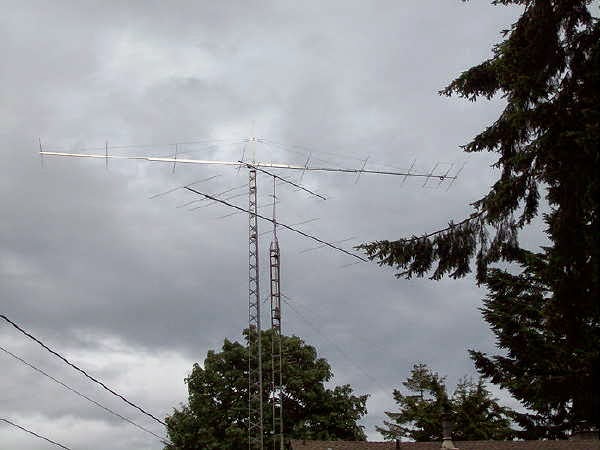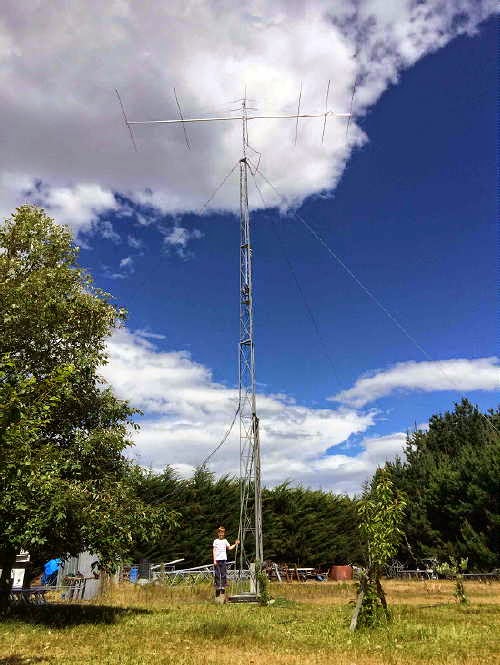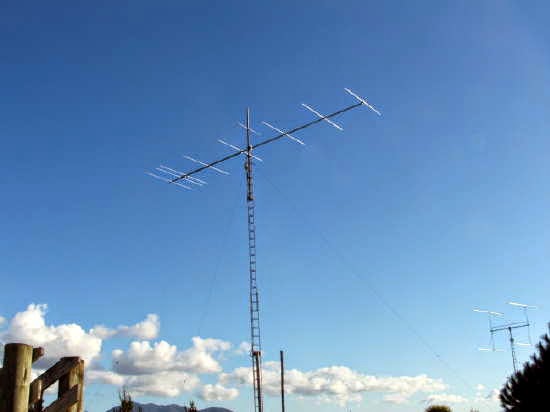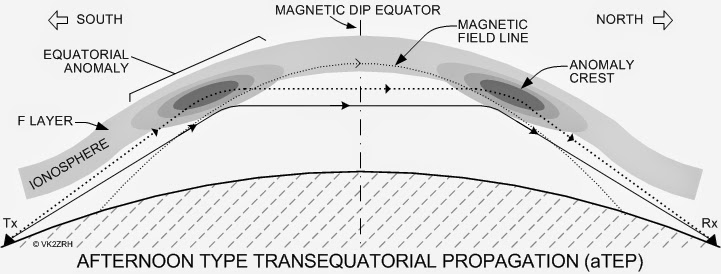 House Number Four
House Number Four
 It seems that if I'm not chasing down noisy power poles or hunting for drifting wireless headsets, both of which have tried their best to tax my 6m reception this past year, I spend several hours each year chasing down delinquent noise generators!
It seems that if I'm not chasing down noisy power poles or hunting for drifting wireless headsets, both of which have tried their best to tax my 6m reception this past year, I spend several hours each year chasing down delinquent noise generators! I spent yesterday afternoon searching the neighbourhood for the source of an annoying and disruptive 120Hz hum. Testing my patience for about a week now, the AC buzz has been ripping-into my usually quiet LF reception, disrupting efforts to participate in the latest CLE (189) listening event. Although conditions have been poor, as usually occurs during these events, the signal-shrouding AC hum has made the event a real struggle.
I had been hoping that, whatever the source of the suddenly-appearing interference was, it would disappear as quickly as it had arrived. I had first noticed it several weeks ago, but it would always go off around bedtime and often was not there at all in the evenings...but the past week it has been there 24/7.
Yesterday I had finally had enough and with Sony 2010 in hand, along with its built-in ferrite bar antenna, I tuned the radio to 630m and started walking around the neighbourhood.
The first thing I noticed was that the signal was being propagated along the overhead powerlines and it was difficult to get a direction of the true source...all nulls pointed to the closest line. Walking to the north, the signal gradually became weaker and reversing direction to the south produced an ever-increasing AC hum...progress! I eventually found a corner where the QRN peaked, and walking in all directions from that point saw the noise diminish...getting warmer!
There were four possible homes here that could be the cause of the problem. I spoke with three of the four homeowners, all of whom seemed genuinely concerned about the source. They all let me into their homes and, with radio in hand, look for the source of the (by now) loud buzz. None of the three homes seemed to furnish the nasty noisemaker.
House number four was unoccupied but was, I was told, up until about a week ago. Venturing on to the property, the S9 buzz started to climb and by the time I had reached the porch, the Sony was on the verge of self-implosion...getting very hot now! A knock on the door confirmed that nobody was home but...behind the curtain, there it was...a floor lamp was turned ON!!
With the source now located I could now breath a little easier but unfortunately could not hear any quieter. Hopefully the owners, who go back and forth to the mainland frequently, will return soon and that LF will once again sound as it should.
 What could be screwed into that floor lamp? I'm betting on a poor-quality or about-to-fail CFL bulb.
What could be screwed into that floor lamp? I'm betting on a poor-quality or about-to-fail CFL bulb. The one on the left is the actual bulb that I removed from a crawlspace, about four years ago, three houses away. It had been creating the same sort of buzz, only louder, as it was much closer. It was not emitting any light whatsoever yet continued to generate noise as well as present a real fire hazard. The house occupants had left it switched 'on' in order to discourage the local otter population from making a winter home in their crawlspace. Somewhere along the line the bulb had failed and started generating large amounts of AC hum.
This one was tough to find, as even several blocks away, it was very loud. It seems that power lines make wonderful LF antennas. I had to make a map showing signal strengths at many locations to find the source... my neighbours have since given me a key to their house, just in case it happens again!
So...what do you think is in house number four?
Steve McDonald, VE7SL, is a regular contributor to AmateurRadio.com and writes from British Columbia, Canada. Contact him at ve7sl@shaw.ca.
 What I’ve been playing with over Christmas and New Year (anyone want a nice FT1000MP?)
What I’ve been playing with over Christmas and New Year (anyone want a nice FT1000MP?)
With my return to work on the horizon on Monday, I’ve been thinking about what a nice holiday I’ve had. Although I’ve had to do a bit of work here and there, it’s not been too onerous which has been welcome.
I’ve not done anything exceptionally different this holiday, but it’s been nice varied activity. There have been a couple of sessions when I bounced my 144MHz packet signals through the digipeater on the International Space Station. That’s always satisfying and nice to do – particularly with a very simple aerial.
I missed the ISS’ SSTV operations but all of that made me think about operating SSTV a little and it’s been fun to play with and I’ve had 2 or 3 nice ‘QSOs’ or picture exchanges with many other pictures being seen.
Tim Kirby, G4VXE, is a regular contributor to AmateurRadio.com and writes from Oxfordshire, England. Contact him at tim@g4vxe.com.
 What I’ve been playing with over Christmas and New Year (anyone want a nice FT1000MP?)
What I’ve been playing with over Christmas and New Year (anyone want a nice FT1000MP?)
With my return to work on the horizon on Monday, I’ve been thinking about what a nice holiday I’ve had. Although I’ve had to do a bit of work here and there, it’s not been too onerous which has been welcome.
I’ve not done anything exceptionally different this holiday, but it’s been nice varied activity. There have been a couple of sessions when I bounced my 144MHz packet signals through the digipeater on the International Space Station. That’s always satisfying and nice to do – particularly with a very simple aerial.
I missed the ISS’ SSTV operations but all of that made me think about operating SSTV a little and it’s been fun to play with and I’ve had 2 or 3 nice ‘QSOs’ or picture exchanges with many other pictures being seen.
Tim Kirby, G4VXE, is a regular contributor to AmateurRadio.com and writes from Oxfordshire, England. Contact him at tim@g4vxe.com.
 Marketing With Morse Code
Marketing With Morse Code
Code-is-not-dead prognosticators and hand-wringers will be happy to hear Asus is touting a new smartphone camera feature with Morse code. The smartphone feature has something to do with dual cameras and exceptional zoom capability but unfortunately appears to have no use of Morse code. But a tip of the hat to Asus marketing folks for using code!
Anthony, K3NG, is a regular contributor to AmateurRadio.com.
 New Year’s Eve Magic
New Year’s Eve Magic
 |
| 9el LFA at VE7DAY |
During the last solar rotation, flux values rose to near-Cycle highs and quickly plummeted, along with any hope of finding that six-meter Holy Grail...long-haul F2 propagation. Many six meter ops quickly found other things to do.
One person that didn't stop watching, and never does, was John - VE7DAY, in Campbell River, B.C., on Vancouver Island. John is VE7's iron man of 6m and spends almost 100% of his radio time seeking the magic.
For the past few winters, John has pointed his beam towards the south Pacific at around sunset, and called CQ from the VE7 black hole....on Tuesday evening he was justly rewarded.
At 00:50 UTC on the 31st, John's CQ was answered by Roger, ZL3RC in Christchurch, on New Zealand's South Island...12,021km from Campbell River.
 |
| 6el Yagi at ZL3RC |
One minute later, John worked Chris, ZL2DX, in Martinborough, on the North Island.
 |
| 8el Yagi at ZL2DX |
At 0111 UTC, John completed the hat-trick by working Paul, ZL4PW, in Oamaru, back on the South Island.
 |
| Paul, ZL4PW / 7el at 7m |
"Decades ago, many DXers believed that Argentina was the world DX hot spot. DXers and contesters seemed to do the best down there. When I was in Brazil, one of the places I lived in was the state of Mato Grosso do Sul, PT9-land. It was only about an hour-and-a-half's drive to the Paraguay border, so conditions there were pretty near like those in Argentina, which was also nearby. I ran 100 watts to a vertical wire taped to a bamboo rod... and thought my QTH must have been included in the hot spot area.
I think now we are becoming aware of another hot spot, this one being in North America on Vancouver Island. I'm speaking, of course, of the your QTH, John! You seem to be doing quite well from that location. Keep it up!!
I see you worked clear down to ZL4. I'm envious. I've been looking for a ZL4 contact for a long time. Today when the band was open to ZL, I was on the road returning from Tacoma. Well, I'm glad you were able to work that great DX.
I will change the Distance Scoreboard to indicate the new records you established today. Congrats!
73, Paul K7CW"
With the present dismal solar flux and low solar activity, it is not likely that these contacts were via the F2 mode, but you wouldn't know it from the size of John's signal, recorded by ZL3RC. Being in the middle of our secondary sporadic-E season, north of the equator and at the peak of the major Es season down-under, I think a better candidate is an Es-link from both sides into the Trans Equatorial afternoon 'bubble'....certainly Es from both ends into whatever is happening in the ionospheric cauldron at the equator!
All four stations were running high power and big antennas, and with a little help from the seasonal E, it all seems to have come together nicely.

Congrats to all involved, and especially John, as all of the other 6m ops in this part of the country, including myself, were asleep at the switch it seems!
Steve McDonald, VE7SL, is a regular contributor to AmateurRadio.com and writes from British Columbia, Canada. Contact him at ve7sl@shaw.ca.
 New Year’s Day 2015
New Year’s Day 2015
I participated in the QRP ARCI New Year's Day Sprint as planned, but was disappointed in the lack of activity. I guess everyone was sleeping off a night of merry-making and partying. In the 2 & 1/2 hours that I was on the air, I made only over just a dozen QRP ARCI contacts. It's a good thing that it's SKN, as the bands were busy and I was able to fill in with a couple rag chews in between to keep me from falling asleep at the key.
15 Meters seemed to be the good band for the Sprint. It was less noisy than 20 Meters, and it seemed that it was there that I was hearing the most activity. Towards the end of the Sprint, 40 Meters perked up with some local QRP activity.
After dinner, I came down to participate in a little more SKN, garnering a few rag chews using my refurbished Vibroplex Original.
I was pleasantly surprised that for not having used it in a while, that my fist wasn't all that bad! I cleaned the contacts by rubbing them using a spare QSL card and re-adjusted the spacing and tension. Pretty soon I was sounding almost as good as my keyer and paddles. Notice I said almost, not quite as good as that but not horrid, either. I guess using a bug is like riding a bicycle - once you become comfortable at it, you never forget how.
I finished up the evening by tuning across 30 Meters to hear 1A0C from the Sovereign Order of Malta (Thanks for the clarification, Karl DK5LP) running a pileup. It was a pretty good pileup but he was quite strong - about 579 and getting stronger. I stayed with him for about a 1/2 hour, trying with 5 Watts. As this is a special one for me, I ended up turning up the juice to 85 Watts and nabbed him on my third attempt after that. The DXpedition is there for about five more days, so I will try again over the weekend using QRP - if I hear them.
The Sovereign Order of Malta is a charitable arm of the Catholic Church. They have been in existence since around 1050 and are dedicated to helping the sick and poor throughout the world. Recently, Raymond Cardinal Burke was named patron of the Sovereign Military Order of Malta, a man whom I admire greatly. It was a special treat to have worked them.
So Amateur Radio-wise, 2015 is off to a flying start. I hope it keeps going that way all year long! Let's see if I can work both Foxes in the 80 Meter Fox hunt tonight. ( I did. Yay! )
72 de Larry W2LJ
QRP - When you care to send the very least!
Larry Makoski, W2LJ, is a regular contributor to AmateurRadio.com and writes from New Jersey, USA. Contact him at w2lj@arrl.net.
 Happy New Year to all
Happy New Year to all
Mike Weir, VE9KK, is a regular contributor to AmateurRadio.com and writes from New Brunswick, Canada. Contact him at ve9kk@hotmail.com.



















